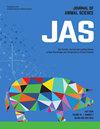PSVI-24 肥育和亚肥育肉用小母牛颗粒细胞和外周血白细胞的基因表达图谱
IF 2.7
2区 农林科学
Q1 AGRICULTURE, DAIRY & ANIMAL SCIENCE
引用次数: 0
摘要
肉用小母牛的繁殖力问题是奶牛-小牛生产行业的一大经济损失。因此,鉴定具有提高繁殖力的遗传潜力的肉用小母牛将提高盈利能力。本研究旨在确定具有不同繁殖潜力的肉用小母牛颗粒细胞和外周血白细胞(pWBC)转录组图谱的差异。为此,对安格斯-西门塔尔杂交小母牛进行了发情同步化和固定时间人工授精(AI)方案(7-D CO-Synch + CIDR),然后让其与能育公牛接触 60 天。根据人工授精后 120 天是否出现受精卵,小母牛被划分为可育(通过人工授精怀孕)或亚可育(通过人工授精或公牛配种未怀孕)。终止妊娠,从每头小母牛身上采集血液和卵巢时,对两组中的所有动物(可育,n = 8;亚可育,n = 5)进行循环。从pWBC和颗粒细胞中提取总RNA,并在Nova-Seq平台上进行文库制备和测序。使用FastQC v0.11.9和MultiQC v1.12进行数据质量控制,并使用STAR aligner v2.7.5与Ensemble的ARS UCD1.2金牛基因组参考进行比对,然后获得读数计数。过滤后的数据使用 DESeq2 进行差异表达分析。我们分别从 pWBC 和 granulosa 中发现了 1,061 和 72 个 P 值≤0.05、绝对值(log2 折合变化)≥0.5 的显著差异表达基因(DEGs)。值得注意的是,在这两种组织中都发现了12个目标基因,包括9个蛋白编码基因(PLCL1、DNER、GNAS、CDH3、PER1、ITGA2B、CXCL12、ENSBTAG00000048613、ENSBTAG00000051519)、bta-mir-2887-1、5-8S-rRNA和U5。根据 PCIT 的差异共表达分析,我们发现 GNAS 和 DNER 是 pWBC 和亚肥育小母牛组颗粒细胞中的枢纽基因。这 12 个共享基因在 NF kappa B 和趋化因子信号转导、肌动蛋白细胞骨架调控和血小板活化等通路中的代表性较高。其中一些已发现的基因以前与生育力有关,而另一些则是新发现的。如果能详细了解顶级基因的潜在生物学机制,并在不同时间点进行样本量更大的后续研究,就能验证本研究中发现的候选基因是否可作为潜在的治疗靶点。本文章由计算机程序翻译,如有差异,请以英文原文为准。
PSVI-24 Gene expression profiles of granulosa and peripheral white blood cells from fertile and sub-fertile beef heifers
Beef heifer fertility issues contribute to a major economic loss in the cow-calf production industry. Therefore, identifying beef heifers with superior genetic potential for improved fertility would increase profitability. This study aimed to identify differences in the transcriptome profiles from granulosa and peripheral white blood cells (pWBCs) of beef heifers with varying reproductive potential. For this, Angus-Simmental crossbred heifers were subjected to an estrus synchronization and fixed-time artificial insemination (AI) protocol (7-D CO-Synch + CIDR) followed by exposure for 60-d to a fertile bull. Depending on the presence or absence of conceptus 120 d post-AI, heifers were classified as fertile (pregnant by AI) or sub-fertile (non-pregnant by AI or bull-breeding). Pregnancies were terminated, and all animals in both groups (fertile, n = 8; and sub-fertile, n = 5) were cycling when the blood and ovaries were collected from each heifer. Total RNA was extracted from the pWBCs and granulosa cells and subjected to library preparation and sequencing on the Nova-Seq platform. The read counts were obtained after data quality control using FastQC v0.11.9 and MultiQC v1.12 and alignment to the Ensemble’s ARS UCD1.2 Bos taurus genome reference using STAR aligner v2.7.5. The filtered data were subjected to differential expression analysis using DESeq2. We identified 1,061 and 72 significantly differentially expressed genes (DEGs) with P-values ≤ 0.05 and absolute (log2 fold change) ≥ 0.5 from pWBC and granulosa, respectively. Notably, 12 targets including 9 protein coding genes (PLCL1, DNER, GNAS, CDH3, PER1, ITGA2B, CXCL12, ENSBTAG00000048613, ENSBTAG00000051519), bta-mir-2887-1, 5-8S-rRNA and U5 were found as DEGs in both the tissues. Based on a differential co-expression analysis using PCIT, we identified GNAS and DNER as hub genes in pWBC and the granulosa cells of the sub-fertile heifer group. The 12 shared genes were over-represented for pathways such as NF kappa B and chemokine signaling, regulation of actin cytoskeleton, and platelet activation. Some of the identified genes have been previously associated with fertility, while others are novel. A detailed understanding of the underlying biological mechanisms of the top genes and a follow-up study with a larger sample size at different time points could validate the candidates identified in this study for their role as potential therapeutic targets.
求助全文
通过发布文献求助,成功后即可免费获取论文全文。
去求助
来源期刊

Journal of animal science
农林科学-奶制品与动物科学
CiteScore
4.80
自引率
12.10%
发文量
1589
审稿时长
3 months
期刊介绍:
The Journal of Animal Science (JAS) is the premier journal for animal science and serves as the leading source of new knowledge and perspective in this area. JAS publishes more than 500 fully reviewed research articles, invited reviews, technical notes, and letters to the editor each year.
Articles published in JAS encompass a broad range of research topics in animal production and fundamental aspects of genetics, nutrition, physiology, and preparation and utilization of animal products. Articles typically report research with beef cattle, companion animals, goats, horses, pigs, and sheep; however, studies involving other farm animals, aquatic and wildlife species, and laboratory animal species that address fundamental questions related to livestock and companion animal biology will be considered for publication.
 求助内容:
求助内容: 应助结果提醒方式:
应助结果提醒方式:


